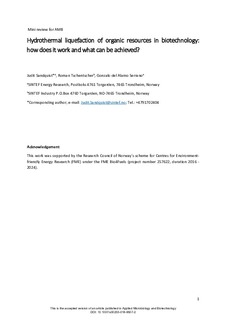| dc.contributor.author | Sandquist, Judit | |
| dc.contributor.author | Tschentscher, Roman | |
| dc.contributor.author | del Alamo Serrano, Gonzalo | |
| dc.date.accessioned | 2019-01-29T13:33:21Z | |
| dc.date.available | 2019-01-29T13:33:21Z | |
| dc.date.created | 2018-11-26T13:22:35Z | |
| dc.date.issued | 2018 | |
| dc.identifier.issn | 0175-7598 | |
| dc.identifier.uri | http://hdl.handle.net/11250/2582861 | |
| dc.description.abstract | Increasing the overall carbon and energy efficiency by integration of thermal processes with biological ones has gained considerable attention lately, especially within biorefining. A technology that is capable of processing wet feedstock with good energy efficiency is advantageous. Such a technology, exploiting the special properties of hot compressed water is called hydrothermal liquefaction. The reaction traditionally considered to take place at moderate temperatures (200–350 °C) and high pressures (10–25 MPa) although recent findings show the benefits of increased pressure at higher temperature regions. Hydrothermal liquefaction is quite robust, and in theory, all wet feedstock, including residues and waste streams, can be processed. The main product is a so-called bio-crude or bio-oil, which is then further upgraded to fuels or chemicals. Hydrothermal liquefaction is currently at pilot/demo stage with several lab reactors and a few pilots already available as well as there are a few demonstration plants under construction. The applied conditions are quite severe for the processing equipment and materials, and several challenges remain before the technology is commercial. In this review, a description is given about the influence of the feedstock, relevant for integration with biological processing, as well as the processing conditions on the hydrothermal process and products composition. In addition, the relevant upgrading methods are presented | nb_NO |
| dc.description.abstract | Hydrothermal liquefaction of organic resources in biotechnology: how does it work and what can be achieved? | nb_NO |
| dc.language.iso | eng | nb_NO |
| dc.publisher | Springer | nb_NO |
| dc.rights | Attribution-NonCommercial-NoDerivatives 4.0 Internasjonal | * |
| dc.rights.uri | http://creativecommons.org/licenses/by-nc-nd/4.0/deed.no | * |
| dc.title | Hydrothermal liquefaction of organic resources in biotechnology: how does it work and what can be achieved? | nb_NO |
| dc.type | Journal article | nb_NO |
| dc.type | Peer reviewed | nb_NO |
| dc.description.version | acceptedVersion | nb_NO |
| dc.source.journal | Applied Microbiology and Biotechnology | nb_NO |
| dc.identifier.doi | 10.1007/s00253-018-9507-2 | |
| dc.identifier.cristin | 1635105 | |
| dc.relation.project | Norges forskningsråd: 257622 | nb_NO |
| cristin.unitcode | 7548,70,0,0 | |
| cristin.unitcode | 7401,80,40,0 | |
| cristin.unitname | Termisk energi | |
| cristin.unitname | Prosessteknologi | |
| cristin.ispublished | true | |
| cristin.fulltext | postprint | |
| cristin.qualitycode | 1 | |

